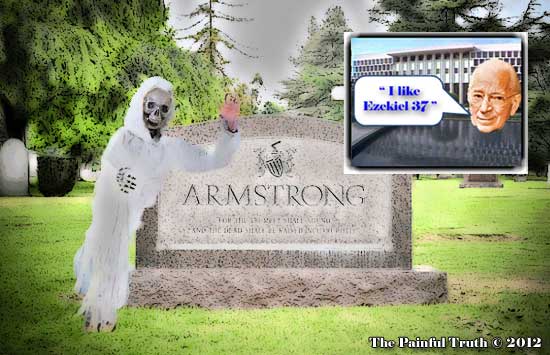|
|
"Ezekiel 37" by Douglas Becker |
|
I was sitting in the foyer of the hotel where the Feast was being kept last year, just before the “Last Great Day” Sermon was to be preached the next day, when the minister for the site came by on his way up to his room. We exchanged pleasantries and I queried about the sermon he was planning to preach. “Oh,” he said, “I like Ezekiel 37′. “I like Revelation 20,” I said, knowing a few things he did not know at the time. He replied, “I like Ezekiel 37′. “I like Revelation 20,” I said. His final word as he headed upstairs: “I like Ezekiel 37′. The next day he preached on what a big deal The Last Great day is using Ezekiel 37 (I’ve heard it; it’s rubbish). I reflected on how set people become in their belief system without ever questioning it, but it’s even worse than that: Herbert Armstrong has so fouled up Scripture with his distorted perceptions that he has ruined Biblical eschatology for believers pretty much for the rest of their lives. The problem is that he managed to make a link to totally disparate verses to make the Bible say what it does not say. At the same time, even though those who leave the Armstrongist community never manage to figure out what is screwed up and never seem to come up with cogent reasons why even believers should not retain the heresies taught by Herbert Armstrong. Now some who left and are not believers may not think it makes any difference to them personally any more, but within the deep dark shadows of the back alleys of the mind, there are cobwebs with inconvenient lies lurking. Besides, we owe believers an explanation why they should not believe this stuff from a Scriptural point of view, out of respect. Herbert Armstrong managed to link Ezekiel 37 to Revelation 20 to prove — by reason that the Word is to be established in the mouths of two or three witnesses — that the passage is talking about the Second Resurrection at the end of the Millennium. This linkage is fraught with so many wrong assumptions that it is difficult to untangle them and, not having sufficient incentive nor drive to disprove the madness of the false prophet, they meekly let the irrational belief system stand. The first thing we need to do, if we believe either passage in Scripture (a broad leap for some), is to separate the two passages completely and accept the possibility that they not just aren’t related to each other in any way, but don’t mean the same thing at all. Fortunately, we have the help of the K & D commentary:
Darby comments:
JFB brings the issue into sharp focus:
The situation was this: The people of Israel were in captivity and some of them were dispersed among the nations. The people in captivity considered that the land of Israel itself was “dead” full of dried bones. Ezekiel offers them hope that life would be restored to the Land of Israel. Thus the passage in its context is not talking about a general resurrection of the dead, but a prophesy that the nation in the Land of Israel would be restored — it had nothing to do with people of the earth being resurrected at the end of the millennium. In fact, since most of Israel was in captivity, the restoration of Israel as a nation is what would have made sense to them in context. Ezekiel was attempting to encourage the people that they would return to Palestine and Israel would be “resurrected”. Given their state in Babylon, the proposition that all of humanity was being resurrected to the time of the Second Resurrection would neither be relevant, nor would it make any sense to them in context. Why would they care? But Herbert Armstrong had an agenda: He had to set up a scenario that would coincide with the Feast Days in order to keep his followers enslaved to a tithing system based on the Old Covenant — while being seriously warped in concept — for his own benefit. The prophecy in Ezekiel 37, such as it was, was actually fulfilled under the Reign of Darius around 538 B.C. when the Israelites began returning to their homeland. Herbert Armstrong needed this passage in order to hold together various non fitting parts of his religion. There is no such thing as three tithes — in fact, the words “second tithe” and “third tithe” do not appear in Scripture. He had to justify the keeping of the Feast of Tabernacles and the Last Great Day of the Feast. He put together a scenario to “prove” his position in order to keep people enslaved to his ideas which don’t really have Scriptural support nor are they particularly relevant to the broad spectrum of modern Christians. At best, keeping the Feast may be a blessing, but certainly would not be if it were a vehicle for doomsday sermons based on British Israelism. It depends entirely upon whether a person is seeking “spiritual” content or is focused on the physical and social aspects of a Church Corporate Symposium (Symposium — from the Greek word meaning “drinking party”, which, from all accounts, is truly relevant to the Armstrongist Churches of God). It’s a church convention that precludes the possibility of a true family vacation, since, for the wage earner, there is neither vacation time, nor money, to do both. For retired people on pensions on which tithes (remembering that tithes are payed on produce, not wages) have already been paid, keeping the Feast is doubly problematic. Nevertheless, your current End Time Apostle must be kept in the lifestyle of an Oriental Potentate: It is a moral imperative (one wonders at the personal moral imperatives ignored by such a proposition — namely, one who does not provide for his family is worse than an infidel). Now it is the case that by analogy, in the spirit of things, Armstrongists would like to see their own private version of Ezekiel 37 come to pass: Herbert Armstrong’s dried bones having sinews and flesh restored to them, having him set on his feet in very ample flesh in the midst of Ambassador College — to stand again and take control as the End Time Apostle and false prophet of the Worldwide Church of God and the A.C. Campus, yelling and shouting obstreperously about the restoration of all his things, shaking his jowels and declaring a restitution of his power, money and ego to their former glory and prominence. They want to see “The Plain Truth” once again, in glorious color in their newsstands and see Armstrong making “The World Tomorrow” yet again. That isn’t going to happen, but it would be glorious: The war between him and his former evangelists still standing would not be so much as terribly entertaining. If you think he had issues with Roderick Meredith before — this would be World War III. Of some, such as Ronald Weinland and Gerald Flurry, he would say, “I never knew you” and their kingdoms would collapse… I think. Even if it were to happen, we’re pretty sure it wouldn’t be from God. So you have a lot to think about. The minister liked Ezekiel 37. I like Revelation 20.
|
|
If you have anything you would like to submit to this site,
|

